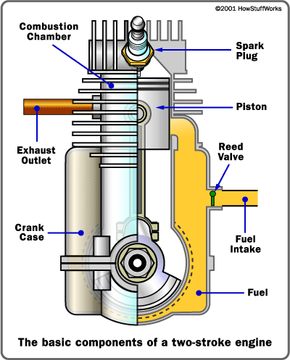Two-stroke Basics
This is what a two-stroke engine looks like:
You find two-stroke engines in such devices as chain saws and jet skis because two-stroke engines have three important advantages over four-stroke engines:
Advertisement
- Two-stroke engines do not have valves, which simplifies their construction and lowers their weight.
- Two-stroke engines fire once every revolution, while four-stroke engines fire once every other revolution. This gives two-stroke engines a significant power boost.
- Two-stroke engines can work in any orientation, which can be important in something like a chainsaw. A standard four-stroke engine may have problems with oil flow unless it is upright, and solving this problem can add complexity to the engine.
These advantages make two-stroke engines lighter, simpler and less expensive to manufacture. Two-stroke engines also have the potential to pack about twice the power into the same space because there are twice as many power strokes per revolution. The combination of light weight and twice the power gives two-stroke engines a great power-to-weight ratio compared to many four-stroke engine designs.
You don't normally see two-stroke engines in cars, however. That's because two-stroke engines have a couple of significant disadvantages that will make more sense once we look at how it operates.
